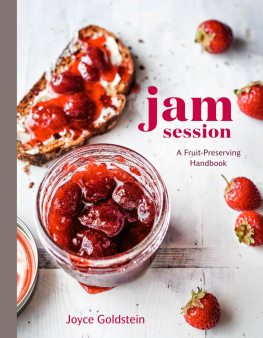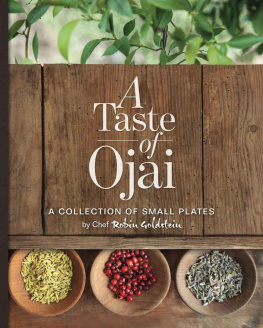
antipasti
Fabulous Appetizers and Small Plates
by Joyce Goldstein
Wine Recommendations by Jeffrey Meisel
Photographs by Paolo Nobile

Text copyright 2006 by Joyce Goldstein.
Photographs copyright 2006 by Paolo Nobile.
All rights reserved. No part of this book may be reproduced in any form without written permission from the publisher.
Library of Congress Cataloging-in-Publication Data available.
ISBN: 978-1-4521-2651-7
Designed by Vanessa Dina
Food stylist: Marco Melissari
Props stylist: Federica Bianco di San Secondo
Typesetting by Janis Reed
The photographer wishes to thank the following for their contributions to the book: ABITO QUI; Milan, Italy; Tel +39 02 290025184 :: ARMANI CASA; Milan, Italy; Tel +39 02 723181; www.armanicasa.it :: ARMANI CASA; New York, NY; Tel (212) 3341249 :: BORMIOLI ROCCO & FIGLIO S.P.A.; Fidenza, Italy; Tel +39 0524 5111, www.bormiolirocco.com :: BORMIOLI ROCCO GLASS CO. INC.; New York, NY; Tel (212) 7190606 :: CHRISTIANE PERROCHON; Capannole, Italy; Tel +39 055 9910320; www.christianeperrochon.com :: GIUSEPPINA BARANGIOLA; Lurate Caccivio, Italy; Tel +39 031492404 :: LA CHIAVE DI VOLTA; Milan, Italy; Tel +39 02 8356252 :: MACELLERIA MASSERONI; Milan, Italy; Tel +39 02 89403774 :: RINA MENARDI; Gruaro, Italy; Tel +39 0421 280681 :: SAMBONET; Orfengo, Italy; Tel +39 0321 879731; www.sambonet.com :: SAMBONET Inc.; Elizabeth, NJ; Tel (908) 3514800 :: SILVA; Milan, Italy; Tel +39 02 89400788 :: TESSUTI MIMMA GINI; Milan, Italy; Tel +39 02 89400722 :: VINICIO ZACCHETTI :: Milan, Italy; Tel +39 02 8357020
Chronicle Books LLC
680 Second Street
San Francisco, California 94107
www.chroniclebooks.com
Dedication
For my grandchildren, Elena, Adam, and Antonio.

Acknowledgments
MILLE GRAZIE to:
Bill LeBlond for saying it was time to revisit antipasti and for his loving support of my work.
Sharon Silva, the editing goddess, the best in the business, who pushes for accuracy in many languages.
Jeff Meisel for his wine expertise, excellent palate, and passion for Italy.
Vanessa Dina, a superb designer, and Paolo Nobile, whose photographs are enticing and look good enough to eat. It was a pleasure to be working with you again. You make beautiful books.
Food stylist Marco Melissari and prop stylist Federica Bianco di San Secondo. You make the dishes look as appealing as they taste.
Jan Hughes and Doug Ogan, managing editors with eagle eyes, who proofread and catch all the little errors.
Janis Reed for typesetting and Tera Killip, production manager, who makes sure the printing of the book is perfect.
Amy Treadwell, bravo for organizing all of us!
Gary Woo for testing recipes and tasting food with me for over twenty years. Long may this continue.
Paul Ferrari and Carlo Lavuri, for arranging visits to fabulous food purveyors.
Slow Food and the Salone del Gusto for the opportunity to taste Italys best artisanal food products.
Dave, Bill, Bob, Pat, Phyllis, and Mark, an intrepid band of traveling companions, you get the awards for enthusiastic eating.
My family, who once again stepped up to the table and cleaned their plates.
Contents


Introduction
In 1987, I was asked to organize an antipasto luncheon for the first Mediterranean Food Conference, which was to be held in New York. The American Institute of Wine and Food was the event sponsor, and chefs and winemakers from all over the Mediterranean had been invited. As coordinating chef, I contacted American chefs specializing in Italian food and asked them to prepare a signature dish for this prestigious lunch, which was to take place at the then Parker Meridien Hotel. The hotel was to provide a few antipasti, but the main plates were to come from this countrys culinary stars.
On the day of the event, chef Todd English, who then headed up the kitchen at Michelas in Cambridge, had to cancel because of a family emergency, and restaurateur Michela Larsen came and executed his dish, an exquisite stuffed calamari. Evan Kleiman of Caff Angeli in Los Angeles prepared her wonderful eggplant rollatini stuffed with fresh mozzarella. I served an updated version of carne salata , spiced, cured beef fillet seared rare and accompanied with sliced artichokes and shaved Parmigiano-Reggiano cheese. The opening chef of Manhattans Union Square Caf, Ali Barker, served his contemporary interpretation of vitello tonnato . Instead of covering braised veal with tuna sauce, he seared fresh tuna fillet and served it with the classic tuna mayonnaise. To our great surprise, some of the visiting Italians were outraged by the carne salata and tonno tonnato and staged a walkout at the lunch. Rare tuna! Almost raw meat! They claimed they could become sick from eating these barely cooked items.
But why the melodrama? Pesce crudo (raw fish) is a preparation of long standing in the Italian south. Carpaccio (raw beef fillet) has been served at Harrys Bar in Venice since the fifties, and carne cruda (chopped raw veal) is a classic of Piedmontese cuisine. So our dishes were hardly radical; in fact, they were based on tradition. The presentations, however, were contemporary, and the Italians were offended at the so-called liberties we upstart chefs had taken with their antipasti. After a few hours of uproar, Atlantic Monthly editor Corby Kummer solicited a public apology from the Italians to the American chefs and the meeting continued without controversy.
Weve come a long way since those days. Over the past twenty years, an antipasto revolution has taken place. It is not that the traditional antipasti have gone away. Instead, the menu category has been expanded to include dishes that previously have not been considered part of this opening course. If the same conference were held today, there would be no walkouts, and the Italian guest chefs would be serving dishes far more radical than anything the American chefs presented in the mid-eighties.
Antipasto Today
Major lifestyle changes have occurred in Italy since the idyllic time that I lived there many years ago. Except for tourists and a few wealthy Italians who have few time constraints, the long, leisurely lunch hour has vanished, along with the beloved siesta. Women are no longer staying home full-time, managing the household and cooking all the meals. Most people are working longer hours and dining out more often, or relying on prepared foods from the local gastronomia or tavola calda . Given time and money constraints, they usually do not go out for expensive multicourse meals except, perhaps, on special occasions. Instead, dining has become more casual. With the growing number of osterie, tavole calde , simple enoteche , and more elaborate wine bars with expanded food service, Italians can spend lessand taste more. While antipasto is still an opening course on the formal menu, dining on an assortment of antipasti, with small plates as the meal, has become a new way to eat in Italy today.
Next page









